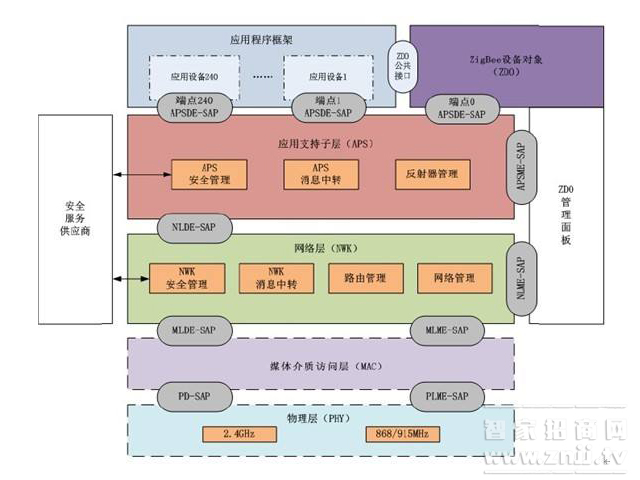ZigBee is a wireless network protocol for low-speed short-distance transmission. ZigBee protocol, respectively from the bottom to the physical layer (PHY), media access control layer Wei g (MAC), a transport layer (TL). Network (NWK) layer and an application layer (APL) and the like. The physical layer and media access control layer follow the provisions of the IEEE 802.15.4 standard. The ZigBee Alliance standardizes network layer protocols and application frameworks.

1, the physical layer. The physical layer of ZigBee technology is divided into 2.4GHz physical layer and 868/915MHz physical layer. Among them, 2.4GHz is operating in the 2.4GHz industrial, scientific and medical frequency bands; and 868/915MHZ physical layer, Europe uses the 868MHz physical layer, the United States uses the 915MHz frequency band, in order to avoid interference, all frequency bands are used Direct-sequence modulation. The available channels are 16, 10, and 1, respectively, each providing 250 kbit/s, 20 kbit/s, and 40 kbit/s transmission rates, and the transmission range is between 10 and 100 rn. They use the same physical layer data packet format except for differences in operating frequency, modulation techniques, spreading chip length, and transmission rate.
The main functions of the physical layer include activating and hibernating radio frequency transceivers, channel energy detection, link quality indication of channel receiving data packets, idle channel evaluation and sending and receiving data.

2. Media Access Control Layer (MAC). The MAC sublayer uses the services provided by the physical layer to implement data frame transmission between devices. At its core is a channel access technique, mainly refers to a random access channel technique (CSMA / CA). This kind of mechanism is that the module officials are tired of hearing the rumors of the township officers and listen to rFl-force. If the channel is idle, it sends data. Otherwise, it delays a random time and then listens again. The time for this evasion is exponential, but There is a maximum value, that is, if the channel is busy listening again after the last backoff, the backoff time will be doubled. The reason for this is that if multiple listening channels are busy, it may indicate that the amount of data on the channel is large, so let the module Wait more time to avoid a busy monitor. With this channel access technology, all modules compete to share the same channel. In the MAC layer which also defines two channel access modes, one beacon (the Beacon) mode and the other non-beacon mode. A "superframe" format is specified in the beacon mode. A beacon frame is transmitted at the start of the superframe, which contains some timing and network information, followed by a contention access period, during which time each module is Access to the channel in a competitive way, followed by non-competitive access, the module accesses the channel in a time-division multiplexed manner, and then in the non-active period, the module enters a dormant state, and waits for the next super-frame cycle to start sending a beacon frame again. The non-beacon mode is more flexible. The modules access the channel in a competitive manner and do not need to periodically send beacon frames. Specifically, in the MAC sub-layer function, the coordinator generates and transmits a beacon frame, and the common device synchronizes with the coordinator according to the beacon frame of the coordinator.
3, the network layer. The network function is the most important feature of ZigBee, and is also different from other wireless LAN standards. In the network layer, its main. The work is responsible for the establishment and management of network mechanisms, and has self-configuration and self-healing capabilities. In the network layer, ZigBee defines three kinds of roles: the first is the network coordinator, responsible for the establishment of the network and the distribution of network locations; the second is the router, which is mainly responsible for finding, establishing and repairing the routing path of the packets, and Responsible for the transfer of information packets; the third is the end device, can only choose to join the network has been formed by others, can send and receive information, but can not forward information, does not have routing capabilities. On the same WPAN, there can be 65,536 ZigBee devices, each of which can transfer information through multiple hops.
The main function of the ZigBee network layer is to set up the network, join the network, and leave the network. It is the core of the routing and routing algorithm. At present, the ZigBee network layer mainly supports two routing algorithms: tree routing and mesh routing. Tree routing refers to the entire network as the coordinator. The entire network is established by the coordinator. The submodules of the coordinator can be routers or end modules. The submodules of the router can also be routers or end modules. The end module does not have submodules. Mesh network routing is a widely used routing algorithm and it has good reliability. It mainly depends on multi-hop technology. Multi-hop refers to data jumping from one module to another. Because data is continuously transferred from one module to another, and because mesh networks have many modules, there is always more than one path from one module to another. After the module joins the network, a path is automatically generated between these modules and the destination module, and the module itself can build a route. As long as the information is sent, the neighboring signal is forwarded after receiving the information. This forwarding process will be repeated module by module until the information arrives at the destination. The confirmation signal provided by the destination module tells the originating module that the complete path has been established and the information has arrived successfully.
4, application layer. The ZigBee application layer has three components, including Application Support Sublayer (APS), Application Framework (AF), and ZigBee Device Object (ZDO). Together, they provide a unified interface for application developers and specify application-related functions such as endpoint specification, binding, service discovery, and device discovery.
The application layer is a ZigBee technology that provides some application framework models for practical applications. This layer provides an interface for data communication between user application processes. When the application process invokes an application layer service, it should provide the parameters required by all services. Then, the application layer service encodes the data and sends it to the network interface layer object. The network layer data transmission service sends data out. After receiving the data from the communication port, the application layer uploads the data to the application layer service. The application layer service transmits the received data to the corresponding user application process in the application layer according to the target application process ID in the service packet. The user application process updates and further processes the corresponding parameters. The main function of the application layer is to define the role of the device in the network (such as the coordinator and the terminal device), set up the network, initiate and respond to binding requests, and deliver messages between bound devices.
For more information on smart security and health product prices, click here!
Waterproof Airline Plugs,Flat Wire Aviation Plug,Nylon Injection Molded Nut Aviation Plug,Waterproof Aviation Plug For Led Luminaire
Shenzhen HuaTao Electronic Co., LTD , https://www.htconnector.com